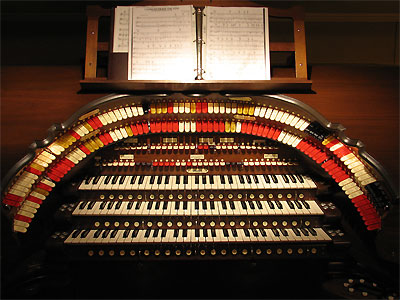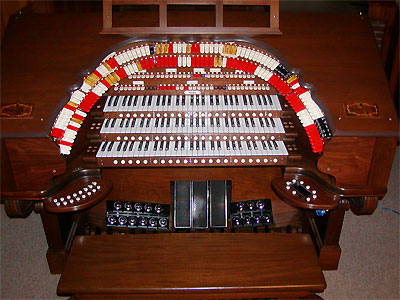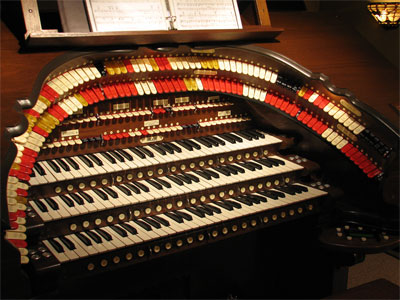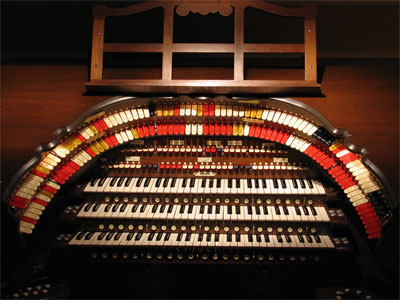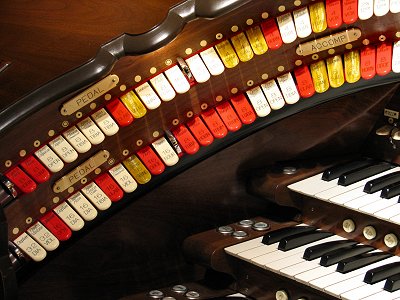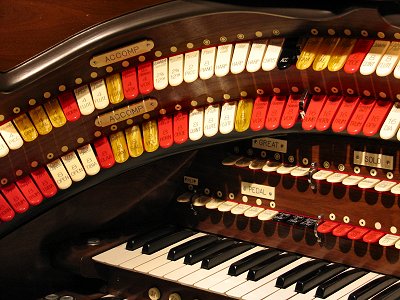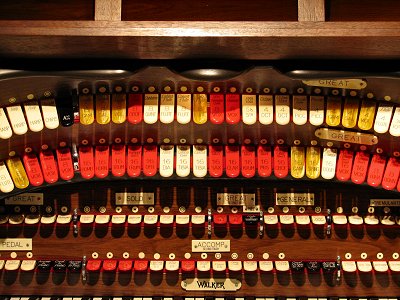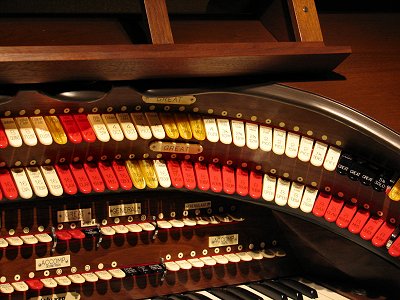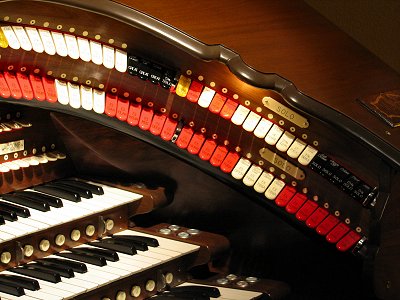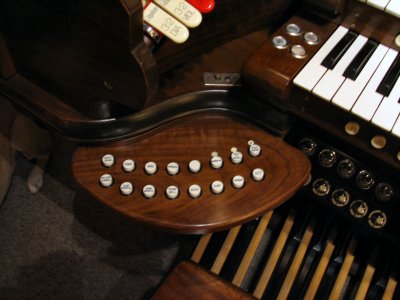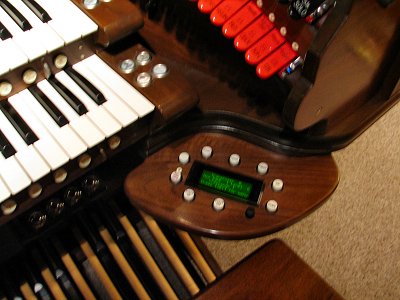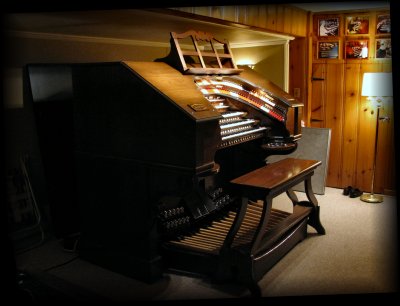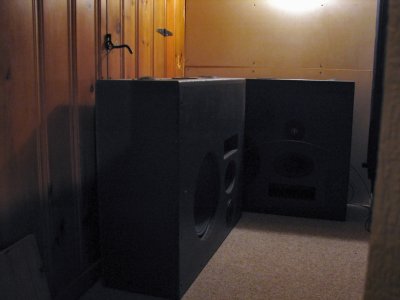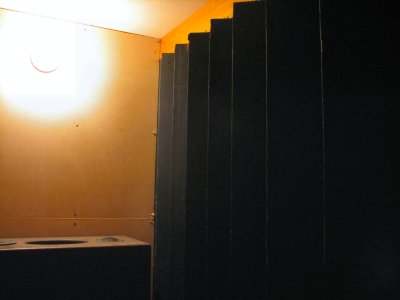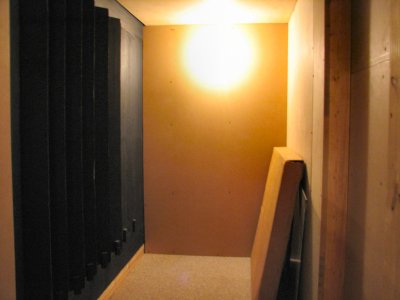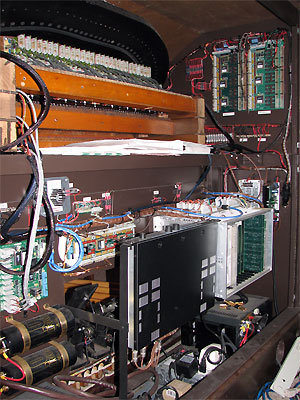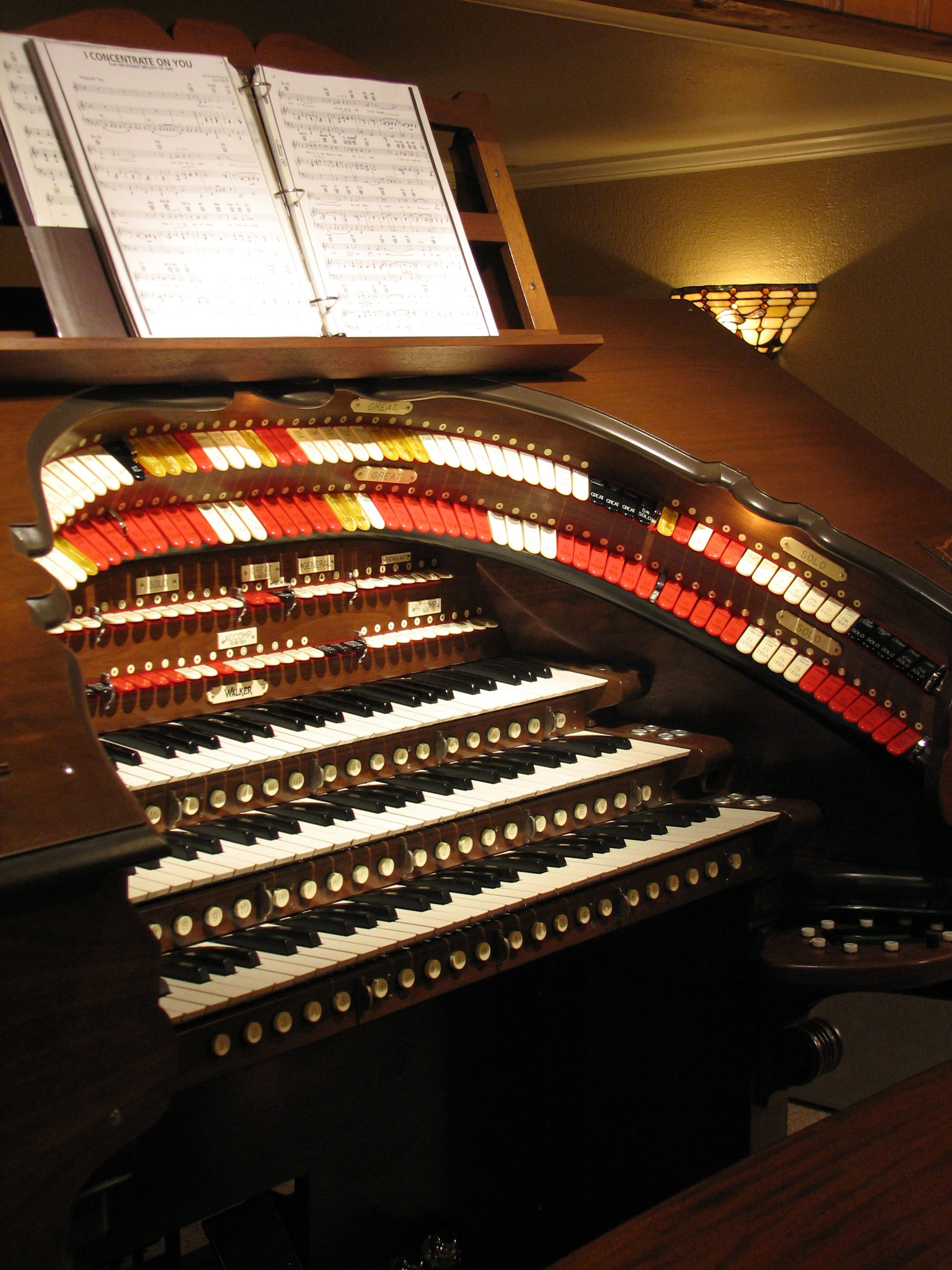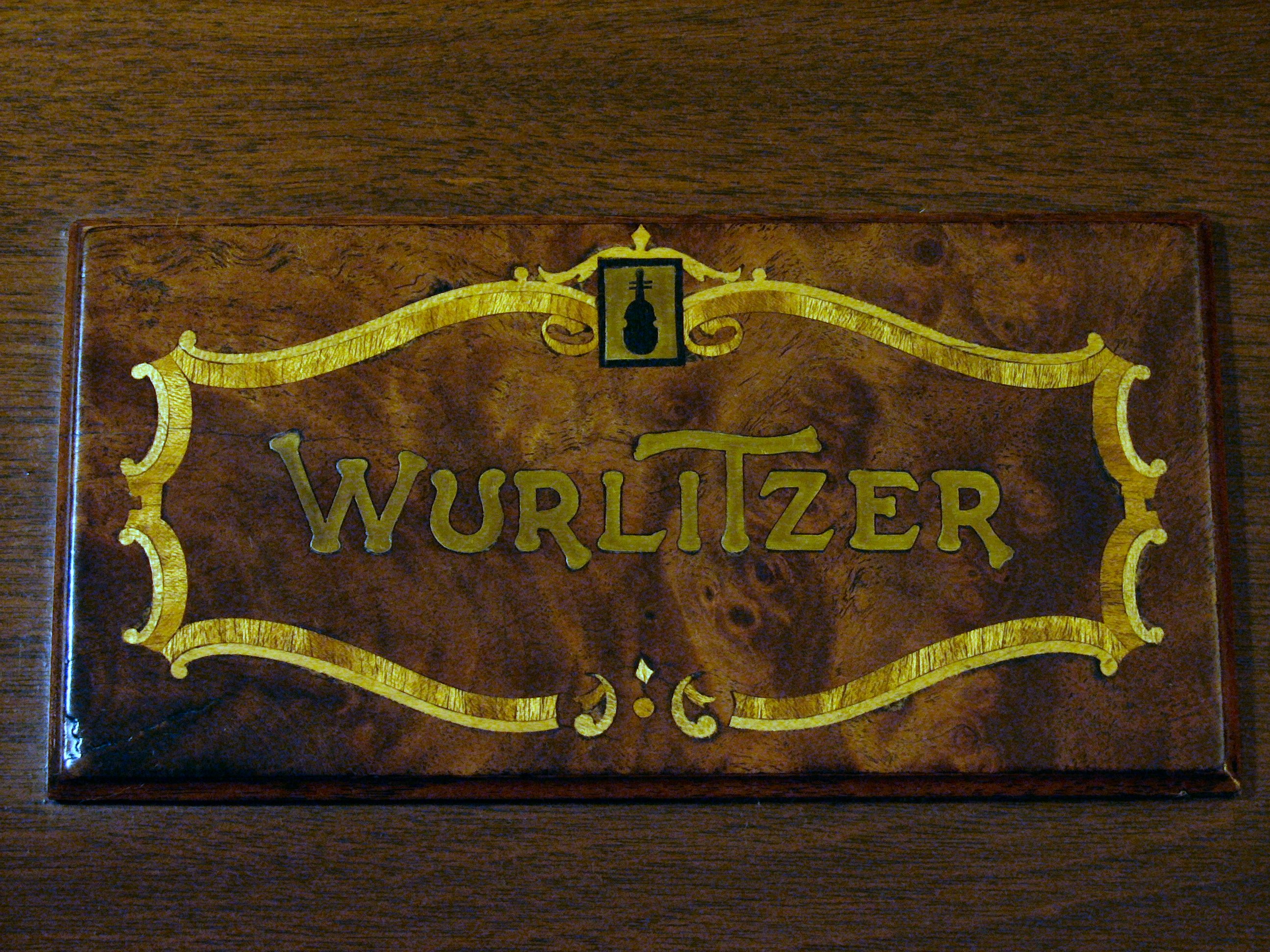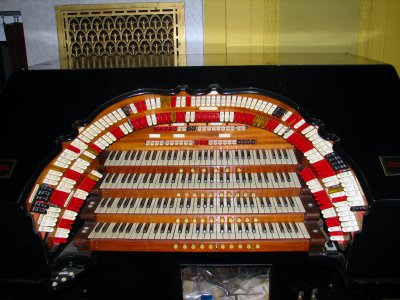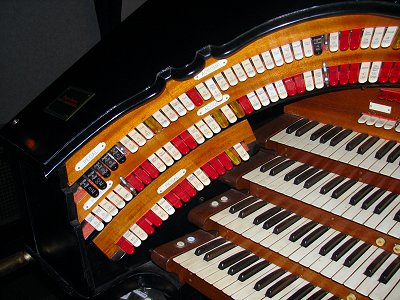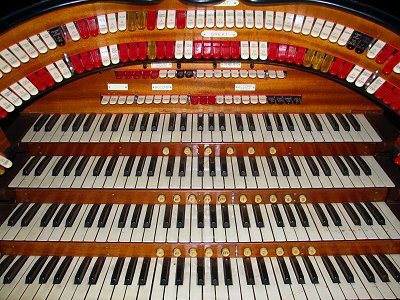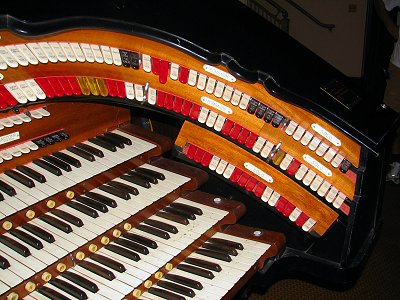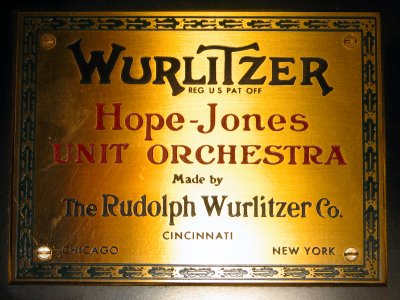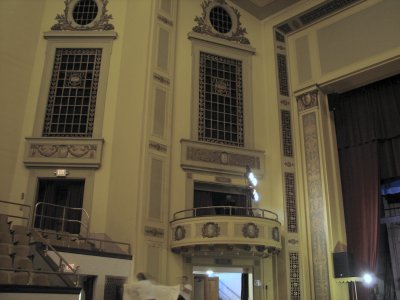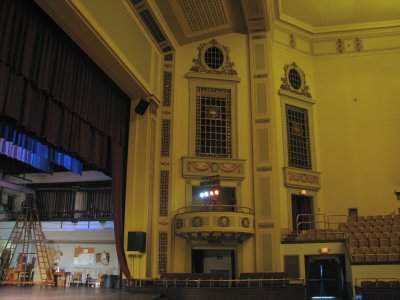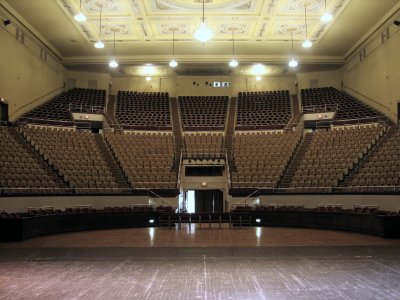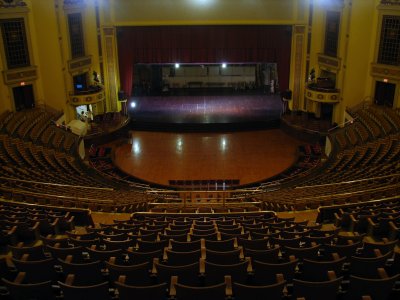
|
|
3/45 Mighty Walker
|
||
|
This month's featured organ is the 3/45 Mighty Walker Custom Digital Theatre Pipe Organ installed at the residence of Doug Powers in Beachwood, Ohio. It is the fourty-second instrument to be featured at Walnut Hill thus far.
The tone of this fine Theatre Pipe Organ is wonderfully up-front, like a fine studio instrument. There is a immediate attack in the acoustics of the basement studio where it resides. Seen in the shot above is the console of this magnificent beast, resting in front of the chambers and unenclosed divisions. |
||
A Closer Look at the Console |
||
|
This Digital Theatre Organ has three manuals, two of which have Second Touch, and fourty-five full compass ranks. There are so many tonal flavours to choose from that it would take centuries to explore the many millions of possibilities this organ offers. The instrument is comfortable to sit at and play, and the sound is clean and powerful, emminating from two chambers and an unenclosed division, along with an ethereal reverb division as unenclosed speakers in the listening area. The sound wraps around you anywhere in the room. It is truly remarkable.
In this shot, we are looking at the keydesk of the beautiful walnut scroll-top console, a true testament to Rudolph WurliTzer's craftsmen. It is a Genuine WurliTzer Style 260 Special shell, built in 1927. High-technology computer gear now fills the machine, with enough power and accuracy to give it the golden voice of real pipes. The only direct illuminations in these shots are the light coming from the large lamp over the console and the small stop rail lamps.
This is the left end of the horseshoe where the Pedal and some of the Accompaniment stops are located. Note the 32 footers in the Pedal. They are contrasting stops, one purrs and the other growls. They both have the low frequency energy that shakes things up. The basement is concrete with lots of wood on the walls and carpet on the floor. It is big as residence basements go, but there is a ton of electronics in this space with enough watts to fill a small auditorium.
This is the left curve of the horseshoe where the rest of the Accompaniment stops are located. We can also see some of the Great stops, and on the fallboard along the back rail we have more Pedal, Great and Solo stops, and some of the Accompaniment Second Touches. The instrument has a wide variety of Second Touch voices and the keyboards are well balanced and regulated, making Second Touch almost second nature by feel. The manuals were consistant from end to end. They had that classic well adjusted WurliTzer feel.
Moving on around the horseshoe, we come to the center bolster containing the Great stops and below these on the top row of the back rail are the rest of the Great and Solo stops, the Great Second Touches, the Generals and the Tremulants. Below these on the bottom row of the back rail, we find the rest of the Redal stops, the Accompaniment Secont Touches and some Percussion stops. The toy counter on this instrument is well equipped and accessable via stops on First and Second Touch, and some of the toys are also on pistons and toe studs.
This is the right curve of the horseshoe where the rest of the Great and some of the Solo stops are found. We can get a good view of the stops in the fallboard along the right end of the back rail as well. Note the large proliforation of red stops. There are some absolutely gorgeous Reeds of all kinds to choose from. This is a grande Unit Orchestra, indeed. It can sound like a symphony in that Fox Special kind of way. A real feast for the ears, yes.
At the right end of the horseshoe are found the rest of the Great stops and the Solo stops. Notice the enormous selection of Reeds in the Solo division. These are orchestral in scope. They can be used one at a time, or in groups for some really awesome chorus tones. THere are horns and woodwinds, large and small, loud and soft, bright and dark, thick and hollow. And the Tibias are simply heavenly. The organ has two of many voices arranged as one in the Main and another in the Solo. The two voices in the pair each have an individual tonality and tuning, so that when the two combine, the effect is spectacular and humongous.
Under the left bolster end block is a swing-out tray called the junk drawer. This contains push buttons for sound effects used during a silent movie. There are birds, whistles, bells, gongs, horse hooves, and more. Of George Wright could take the bench of this fine lady, he would have a blast. Everything a player could want is on this marvelous creation in Doug's home. Under the right bolster end block is a drawer containing the console programmer. This is the human to machine interface for the onboard organ computer. It allows memory setting and recall, MIDI record and playback, and signal routing and balance. It is possible to play the organ and have it play back everything the player did. The stops move. The swell shades move. THe keys do not move during MIDI playback, though. That would just be too spooky, indeed!
Here, we see the basement studio dominated by the console of the 3/45 Mighty Walker Digital Theatre Organ console on the raised platform in front of the chambers. There is actually more space in this room than appears in this picture. Doug has had more than two dozen happy campers seated 'round the Mighty Walker, watching many famous folks have a go on this one-of-a-kind organ, one of today's finest VTPO's. |
||
A Closer Look At The Chambers |
||
|
The 3/45 Mighty Walker Digital Theatre Organ. installed at the Doug powers Residence sounds marvelous, indeed. As we shall see in the pictures to follow, this is a somewhat compact place with such a huge instrument installed inside. But the sound of this lovely lady is truly astounding in detail and imaging, though very powerful and clean. So clean that we wanted to ad blower and trem noise to get a closer approximation of reality. Doug turned on those sounds and I could have sworn I was near a real wind-blown instrument. Here, we see the unenclosed speakers near the main chamber swell shades to the left of the console. Note the clear hemicircilar plexiglass mixing shield in front of the oval speaker. This lets the highs blend better. Doug thought of everything when he built this mighty machine. THe Main and Solo speakers are contained in a soundproof room behind the console. The sound eminates from a shade on each end. It must then turn an "L" as it escapes from the unenclosed speaker areas on either side of the console. This shot offors a different perspective, looking toward the Main Chamber Swell Shades. This shutter assembly gives incredible realism to the tone of the instrument as the sound goes up and down with the opening and closing of the heavy wooden shutters, in a way standard volume controls cannot. As the shades close and the volume fades, the brightness of the tone darkens. The treble decreases. Impressive, for sure. Here, we are looking at the Solo Swell Shades. Having real wooden mechanical shades causes the organ to have the right tone as the volume decreases, wherein the highs roll off just like what happens on a real Theatre Pipe Organ. Since the shades face in opposing directions, separation between the chambers is nice. Out in the listening room, there are two spealers, one in each corner, that carry the ethereal signal. THese create a reverberant field and can simulate the acoustics of many room sizes using real-time convolution.
In this pair of pictures, we see the inside of the console showing the electronics that enable this beast to sould like the real thing. Bob Walker did a super job of building this circuitry, and Doug did a great job putting it all together. The console started life as an actual Mighty WurliTzer, but it was completely redone inside to become Doug's magnificent VTPO, powered by Walker. We also see the console from the outside, and you can plainly see that it is indeed an actual Mighty WurliTzer Style 260 Special Scroll-Top Theatre Pipe Organ console from 1928. Here is one of the two wooden WurliTzer badges that adorn the end horns of the horseshoe lid. Notice how detailed the inlays are in this badge, a true testiment to the loving atenttion the WurliTzer craftsmen paid to detail. It is only fitting that such a beautiful console sould get a new lease on life as a Mighty Walker DTO. We can never thank Dou Powers enough for inviting us into his home and sharing his love of the King of Instruments, and letting the Bone Doctor play the organ and learn some of her sectrets. We had fun. |
||
Another Organ Project |
||
|
The 4/24 Mighty WurliTzer Theatre Pipe Organ being restored for installation at the Masonic Temple in Cleveland is another project which Doug Powers is managing for the Western Reserve Theatre Organ Society, a proud chapter of the ATOS. The left bolster of the horseshoe containing the Pedal and Accompaniment stops. The center bolster of the horseshoe containing the Great stops. The right bolster of the horseshore containing the Solo and Bomboarde stops. Here is one of the two brass WurliTzer badges that adorn the ends of the horseshoe. The Main Chamber is located to the left of the stage. The Solo Chamber is located to the right of the stage. The auditorium as viewed from center stage.
|
||
Coming Soon - Free Music Downloads |
||
|
Below are ? songs performed by the Bone Doctor on August ?th, 2007 at the 3/45 Mighty Walker Digital Theatre Organ installed at the Doug Powers Residence in Beachwood, Ohio during the Ohio Organ Crawl.
|
